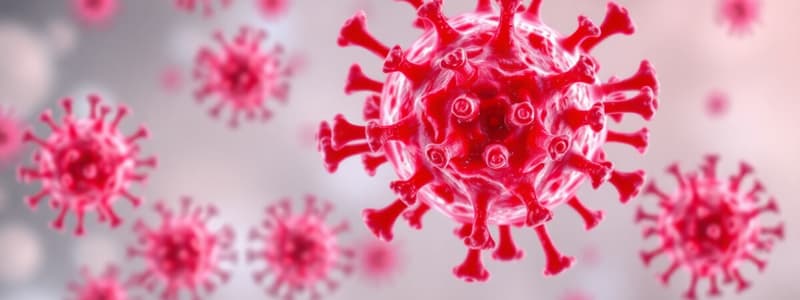Podcast
Questions and Answers
What is the primary aim of the immunology subject in the context of dental therapy and hygiene?
What is the primary aim of the immunology subject in the context of dental therapy and hygiene?
- Applying principles from engineering.
- Applying principles from physics.
- Applying principles from biomedical, behavioral, and material sciences. (correct)
- Applying principles from chemistry.
In the context of immunology, what is the main focus of study?
In the context of immunology, what is the main focus of study?
- Study of nerves
- Study of bones
- Study of muscles
- Study of the immune system (correct)
What type of immunity is developed after the administration of a vaccine?
What type of immunity is developed after the administration of a vaccine?
- Artificial passive immunity
- Natural passive immunity
- Natural active immunity
- Artificial active immunity (correct)
What is 'passive immunity'?
What is 'passive immunity'?
According to the content, what processes may come from antibodies and/or cells?
According to the content, what processes may come from antibodies and/or cells?
What is a result of antibody-mediated immunity?
What is a result of antibody-mediated immunity?
What is a result of cell-mediated immunity?
What is a result of cell-mediated immunity?
Which of the following is an example of a module related to the study of immunology?
Which of the following is an example of a module related to the study of immunology?
What develops after immunisation?
What develops after immunisation?
What is a characteristic of artificial passive immunity?
What is a characteristic of artificial passive immunity?
Flashcards
Passive Immunity
Passive Immunity
Immunity acquired through transfer of antibodies or sensitized cells from an immune to a non-immune individual; it offers short-term protection.
Active Immunity
Active Immunity
Immunity developed in response to an antigen exposure, stimulating the body to produce its own antibodies; it provides long-term protection.
Artificial Active Immunity
Artificial Active Immunity
A type of active immunity where antibodies develop post-vaccine administration.
Natural Active Immunity
Natural Active Immunity
Signup and view all the flashcards
Natural Passive Immunity
Natural Passive Immunity
Signup and view all the flashcards
Natural Active Immunity
Natural Active Immunity
Signup and view all the flashcards
Artificial Passive Immunity
Artificial Passive Immunity
Signup and view all the flashcards
Study Notes
GDC Learning Outcomes
- Focus is placed on applying dental therapy and hygiene principles derived from biomedical, behavioral, and materials sciences.
- A main aim is to build understanding of immunology.
Assessment Types
- Formative assessment is done via a quiz, whilst summative involves Biomedical Sciences Eassessment questions.
Immunology 2 Tasks
- One task includes reading and completing work related to pages 5-8 of the article, "An introduction to immunology and immunopathology" by Richard Warrington et al.
- Another task is to complete a self-assessment quiz on antibody mediated and cell mediated immunity.
Learning Outcomes
- Aim to review antibody-mediated and cell-mediated immunity by reading appropriate resources and completing a self-assessment quiz.
- Goal is to define and recognize the variances between antibody-mediated and cell-mediated immunity.
- There is a need to be able recognise and explain passive and active immunization.
Antibody-Mediated and Cell-Mediated Immunity
- Consolidation of learning is key.
- The Cellular Immune Response is described in a YouTube video.
- Antigen processing and presentation is described on YouTube.
Passive vs Active Immunity:
- Immunity is acquired (adaptive)
- Passive immunity is split into natural and artificial
- Natural passive immunity involves mother’s antibodies through placenta/breast milk.
- Artificial passive immunity involves transferred therapeutic agents like snake antitoxin or immunoglobulin for transplant.
- Passive immunity transfers antibodies or sensitized cells from an immune person to a non-immune one.
- Passive Immunity provides short duration and puts person at risk when immunity runs out.
- Passive Immunity should be used when infection risk is high and the body's own response is not developed.
- Active immunity is split into natural and artificial
- Natural active immunity involves antibodies developed in response to infection.
- Artificial active immunity involves antibodies developed in response to a vaccination.
- Active immunity occurs via production of antibodies against a specific agent after exposure to the antigen.
- Specific antibodies are identified as foreign and the response is specific to a particular antigen.
- Memory: antigen is remembered
Immunisation
- Artificial active immunity is when antibodies develop after immunization/administration of a vaccine occurs.
- Immunological memory is created.
- A specific immune reaction is induced against a weakened/killed microorganism.
- Subsequent infections from the same pathogen raise a stronger and faster defensive reaction.
- The reactions may come from antibodies and/or cells.
- Antibodies attach to specific surface structures on an antigen and activate the complement system.
Studying That Suits You
Use AI to generate personalized quizzes and flashcards to suit your learning preferences.



